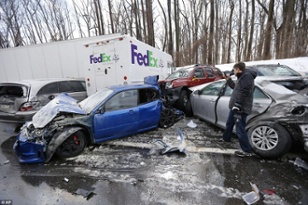FRACTURED BONES AND TWISTED METAL
October will soon turn into November, then December, January, February, and so on. This also means the advent of winter and the return to treacherous snow-covered and icy roads. It was only eight months ago Pennsylvania saw one of the worst accidents in the state’s history.
Back in February, a stretch of the Pennsylvania Turnpike between Bensalem and Willow Grove, was a horrific scene of fractured bones and twisted metal. There were several multi-car accidents, including one involving as many as seventy-five cars and several tractor trailers. According to the Pennsylvania Turnpike Commission, as many as 30 people were injured and taken to nearby area hospitals. While none of the injuries ended up being life-threatening, a few accident victims were transported in serious condition and the most common injuries involved blunt trauma.
The accident started around 8:30 that morning. Officials for the Turnpike Commission believed the first accident involved several tractor trailers and blamed icy conditions and sun glare off the highway as the causes of the first round of accidents. Drivers reported road spray covered windshields and prevented them from seeing a stalled car before it was too late. They simply didn’t have time or space to brake.
In such multi-car crashes, the question is how liability is determined. On that note, Pennsylvania provides a few basic laws:
APPORTIONING LIABILITY IN MULTI-CAR ACCIDENTS
The state follows a comparative negligence doctrine in apportioning liability. This is codified in Title 42 of the Pennsylvania Consolidated Statute § 7502 which states the following:
a) In all actions brought to recover damages for negligence resulting in death or injury to person or property, the fact that the plaintiff may have been guilty of contributory negligence shall not bar a recovery by the plaintiff or his legal representative where such negligence was not greater than the causal negligence of the defendant or defendants against whom recovery is sought, but any damages sustained by the plaintiff shall be diminished in proportion to the amount of negligence attributed to the plaintiff.
What this means is each party – whether plaintiff or defendant – will be responsible for the percentage of damage the courts determines he or she caused. So, for example, if the court determines there was $100,000 in total damage and the Plaintiff was 30% liable, Defendant 1 was 60% liable, and Defendant 2 was 10% liable, then the Plaintiff must pay $30,000, Defendant 1 must pay $60,000, and Defendant 2 must pay $10,000.
IN MULTI-CAR ACCIDENTS, YOU NEED A LAWYER
Determining liability in multi-car crashes can be a complicated and unnerving matter. Every accident is different and present unique circumstances and breaches of a duty of care. As a result, litigation stemming from multi-car crashes usually requires the assistance of counsel who may find not only other drivers at fault but also other parties, such as state agencies. The highly capable and caring attorneys at Stampone Law can help. Whether the accident involves two cars, three cars, or seventy-five, Stampone Law will always be there to help you get the relief you deserve. Contact us today.
